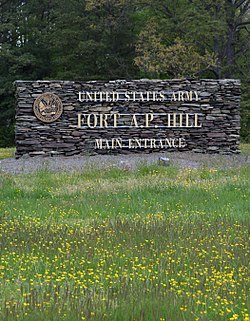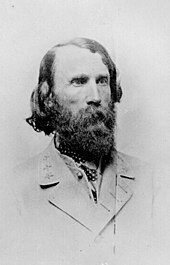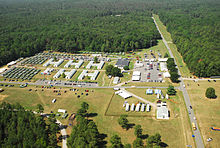| Revision as of 15:21, 14 November 2016 editJkudlick (talk | contribs)Extended confirmed users, New page reviewers, Pending changes reviewers12,258 edits improving layout and readability← Previous edit | Revision as of 04:22, 3 January 2017 edit undoInternetArchiveBot (talk | contribs)Bots, Pending changes reviewers5,383,176 edits Rescuing 2 sources and tagging 0 as dead. #IABot (v1.2.7.1)Next edit → | ||
| Line 13: | Line 13: | ||
| |caption= Photo of the U.S. Army Garrison Fort A.P. Hill front sign on Route 301, in Virginia in the spring. | |caption= Photo of the U.S. Army Garrison Fort A.P. Hill front sign on Route 301, in Virginia in the spring. | ||
| |type=] | |type=] | ||
| |built=June 11, 1941<ref name="APhistory">{{cite web|url |
|built=June 11, 1941<ref name="APhistory">{{cite web|url=http://www.aphill.army.mil/sites/about/history.asp |title=Fort AP Hill, Va • History |accessdate=2007-04-01 |work=Fort A.P. Hill |publisher=U.S. Army ] |deadurl=yes |archiveurl=https://web.archive.org/web/20070409024054/http://www.aphill.army.mil:80/sites/about/history.asp |archivedate=2007-04-09 |df= }}</ref> | ||
| |used=1941—present | |used=1941—present | ||
| |controlledby={{flagicon|United States}} ] | |controlledby={{flagicon|United States}} ] | ||
| Line 58: | Line 58: | ||
| {{Commons category|Fort A.P. Hill}} | {{Commons category|Fort A.P. Hill}} | ||
| * | * | ||
| * | * | ||
| * | * | ||
Revision as of 04:22, 3 January 2017
| Fort A.P. Hill | |
|---|---|
| Caroline County, Virginia | |
 Photo of the U.S. Army Garrison Fort A.P. Hill front sign on Route 301, in Virginia in the spring. Photo of the U.S. Army Garrison Fort A.P. Hill front sign on Route 301, in Virginia in the spring. | |
 | |
| Type | Military base |
| Site information | |
| Controlled by | |
| Website | www |
| Site history | |
| Built | June 11, 1941 |
| In use | 1941—present |
| Garrison information | |
| Current commander | Lieutenant Colonel Andrew Q. Jordan |
| Past commanders | Lieutenant Colonel David A. Meyer Lieutenant Colonel Peter E. Dargle Lieutenant Colonel John W. Haefner Lieutenant Colonel Michael S. Graese Lieutenant Colonel James M. Mis Lieutenant Colonel James B. Balocki |
Fort A.P. Hill, Virginia, is a training and maneuver center belonging to the United States Army, located near the town of Bowling Green, Virginia that focuses on arms training and is used by all branches of the US Armed Forces. It is named for Virginia native and Confederate Lieutenant General A. P. Hill.
History

In the spring of 1940, the War Plans Division of the Army General Staff developed a plan to raise a national army of four million men that would allow it to conduct simultaneous operations in both the Pacific and Europe theaters. In July 1940, a movement began to locate an area of approximately 60,000 acres (240 km), independent of any post, and lying somewhere between the Potomac River and the upper Chesapeake Bay.
Lieutenant Colonel Oliver Marston, an artillery officer stationed in Richmond, Virginia and acting as an agent of the Third Corps Area commander, made a detailed investigation of the Bowling Green, Virginia area in September 1940. He enthusiastically recommended that the War Department procure the Caroline County site. The result was a maneuver area that contained 77,332 acres (312.95 km) and billeting space for 74 officers and 858 enlisted personnel.
Fort A.P. Hill was established as an army training facility on June 11, 1941, pursuant to War Department General Order No. 5. In its first year, the installation was used as a maneuver area for the II Corps and for three activated National Guard divisions from Mid-Atlantic states. In the autumn of 1942, Fort A.P. Hill was the staging area for the headquarters and corps troops of Major General George S. Patton’s Task Force A, which was part of the Western Task Force of the Allied invasion of French North Africa. During the early years of World War II, the post continued to be a training site for corps and division-sized units. Commencing in 1944, field training for Officer Candidate School and enlisted replacements from nearby Forts Lee, Eustis, and Belvoir was conducted.
During the Korean War, Fort A.P. Hill was designated as Camp A.P. Hill and was a major staging area for units deploying to Europe, including the VII Corps Headquarters and the Third Armored Cavalry Regiment. The fort was the major center for Engineer Officer Candidate School training (students from Fort Belvoir) during the Vietnam War.
Construction of the Explosive Ordnance Disposal training center was completed in July 2011 with the first day of class being October 17, 2011. It is named after Captain Jason McMahon, who died in Afghanistan in 2010. The center provides explosive ordnance disposal advanced technical training and tactical skills education for both officer and enlisted.
The US Army Asymmetric Warfare Group officially opened its $90.1 million Asymmetric Warfare Training Center on January 24 2014. The 300-acre (120 ha) training complex includes a headquarters, barracks, administrative, training and maintenance facilities, an urban training area, a 12-mile (19 km) mobility range, an 800-metre (2,600 ft) known distance range, a light demolitions range and an indoor shooting range. This center focuses on providing joint and combined arms training. All branches of the US Armed Forces train at Fort A.P. Hill, and the installation has also hosted training of foreign allies ranging from providing support for mobilizations to helping units train for deployment.
Training

It is used year-round for military training of both active and reserve troops of the U.S. Army, U.S. Navy, U.S. Marine Corps, and U.S. Air Force, as well as ROTC cadets and other government agencies including the Departments of State and Interior, U.S. Customs and Border Protection, and federal, state, and local security and law enforcement agencies.
Boy Scouts of America jamborees


The installation hosted the Boy Scouts of America National Jamboree in 1981, 1985, 1989, 1993, 1997, 2001, 2005, and 2010. The number of participants each time included approximately 35,000 Boy Scouts and some 250,000 visitors. In 2013, the Boy Scouts moved the National Jamboree to its new permanent home at The Summit: Bechtel Family National Scout Reserve high-adventure camp in Fayette County, West Virginia.
References
- "Fort AP Hill, Va • History". Fort A.P. Hill. U.S. Army Installation Management Command. Archived from the original on 2007-04-09. Retrieved 2007-04-01.
{{cite web}}: Unknown parameter|deadurl=ignored (|url-status=suggested) (help) - https://www.army.mil/article/170576/jordan_takes_command_of_us_army_garrison_fort_ap_hill
- https://www.army.mil/article/129058/New_command_team_takes_over_at_Fort_A_P__Hill/
- https://www.army.mil/article/82125/Fort_A_P__Hill_welcomes_new_garrison_commander/
- https://www.army.mil/article/129165/Area_I_has_a_new_garrison_commander/
- https://www.army.mil/article/8527/fort-a-p-hill-wins-army-communities-of-excellence-award/
- ^ "Fort A.P. Hill History". U.S. Army. Retrieved 18 March 2013.
- "Fort A.P. Hill Explosive Ordnance Disposal Training Center honors a fallen hero". U.S. Army. Retrieved 30 September 2014.
- "Asymmetric Warfare Training Center Opens at Fort A.P. Hill". U.S. Army. Retrieved 2 October 2014.
External links
- Wealthy in Heart: Oral History of Life Before Fort A.P. Hill
- History of Fort A.P. Hill page
- Condensed history of U.S. Army Garrison Fort A.P. Hill
| Operational military installations in Virginia | |||||||||||||||
|---|---|---|---|---|---|---|---|---|---|---|---|---|---|---|---|
| Department of Defense |
|  | |||||||||||||
| Army |
| ||||||||||||||
| Marines |
| ||||||||||||||
| Navy |
| ||||||||||||||
| Air Force |
| ||||||||||||||
| National Guard |
| ||||||||||||||
| Coast Guard |
| ||||||||||||||
